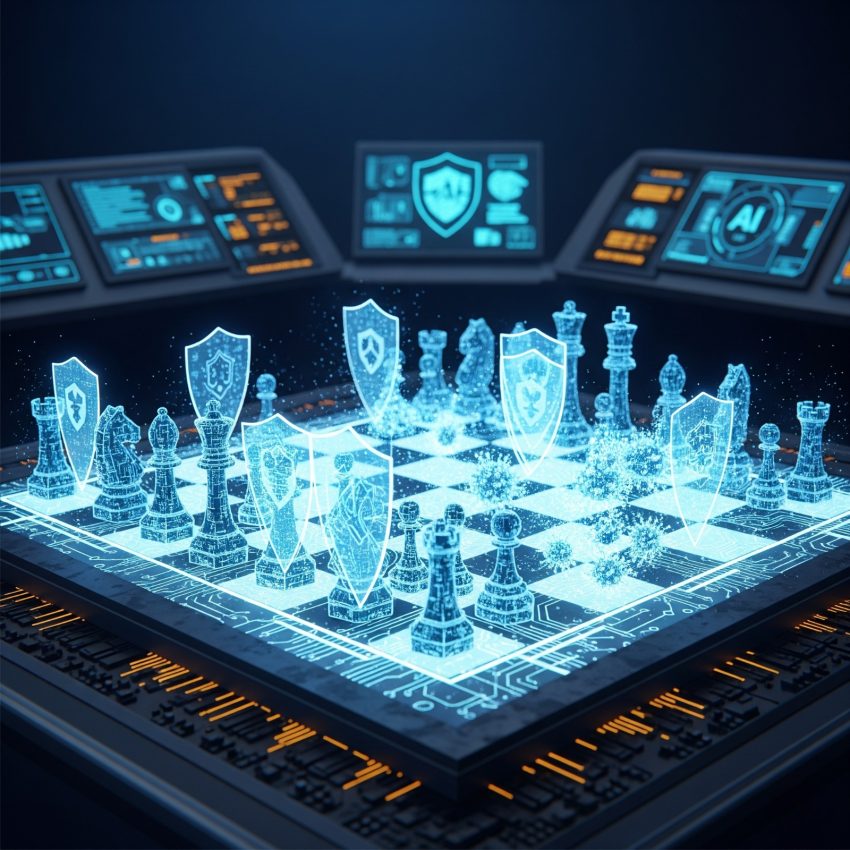The Adaptive Battlefield: How AI Cybersecurity Is Changing the Rules of Digital Defense
How AI in Cybersecurity Is Changing the Rules of Digital Defense – The digital realm has always been a theatre of constant evolution, with threats and defenses perpetually locked in a cycle of innovation. However, the advent of sophisticated Artificial Intelligence has ushered in an era of unprecedented dynamism, transforming cybersecurity from a static defense posture into an adaptive battlefield. AI is not just a new tool in the existing arsenal; it is fundamentally rewriting the rules of engagement, demanding a paradigm shift in how we perceive and counteract threats. We are now navigating a landscape where adversaries and guardians alike possess cognitive capabilities, leading to a continuous, intelligent contest for digital supremacy.
To truly understand this new reality, we must trace the trajectory of cyber threats and how AI represents a quantum leap in their potential and complexity.
From Brute Force to Brainpower: How AI Cybersecurity Is Powering the Evolution of Cyberattacks
Historically, many cyberattacks relied on overwhelming systems with sheer volume or exploiting well-known vulnerabilities through repetitive methods. AI has introduced an element of intellectual agility, allowing threats to become more targeted, nuanced, and persistent.
Consider the evolution of intrusion techniques. Traditional attacks might involve broad network scans looking for open ports or deploying generic exploits. AI-powered intrusion systems, however, can conduct intelligent reconnaissance, learning the specific security configurations and human behaviors within an organization. They can then tailor their attack vectors to exploit the weakest links with surgical precision, remaining undetected through adaptive camouflage. This means moving beyond simply finding a door; AI can analyze the entire building’s architecture and identify the most unguarded window at the most opportune time.
The persistence of threats has also been amplified by AI. Earlier forms of malware often aimed for rapid infection and immediate impact. AI-driven Advanced Persistent Threats (APTs) can operate with far greater stealth and patience. They can establish a low-profile presence within a network, learning its patterns, mapping its critical data flows, and waiting for the perfect moment to strike or exfiltrate information. This prolonged, intelligent infiltration makes detection significantly more challenging, as the malicious activity blends seamlessly with normal network traffic.
Furthermore, AI is democratizing sophisticated attack capabilities. Previously, complex cyber operations required highly skilled human operators. AI-powered tools are lowering the barrier to entry, allowing less experienced attackers to deploy advanced techniques, such as generating convincing social engineering campaigns or automating vulnerability exploitation, at scale.
The Responsive Ecosystem: Strengthening Cyber Resilience with AI Cybersecurity
The escalating sophistication of AI-driven attacks necessitates a corresponding evolution in defensive strategies. Cybersecurity in the age of AI must be less about erecting impenetrable walls and more about fostering a resilient ecosystem that can adapt, learn, and respond in real-time.
Central to this adaptive defense is the deployment of AI-powered threat intelligence platforms. These systems continuously ingest and analyze vast streams of data from diverse sources, identifying emerging threat trends, attack signatures, and adversary tactics. This provides an early warning system, allowing organizations to proactively adjust their defenses and anticipate potential attacks before they occur. It’s like having a global intelligence network constantly feeding your security operations center with the latest information.
AI is also crucial in enhancing incident response capabilities. When a breach does occur, AI-powered tools can automate the initial triage process, rapidly identifying the scope and nature of the attack. They can orchestrate containment measures, such as isolating affected systems, and provide human analysts with prioritized information, significantly reducing the time to resolution and minimizing the potential damage. This speed and efficiency are critical in a landscape where attacks can unfold in mere minutes.
Beyond immediate response, AI plays a vital role in continuous improvement. By analyzing past security incidents and ongoing network activity, AI models can identify patterns and weaknesses in an organization’s security posture. This allows for the continuous refinement of security policies, the optimization of defensive tools, and the proactive patching of vulnerabilities, creating a learning security system that grows stronger over time.
The Cognitive Crossroads: Navigating the Ethical and Strategic Implications of AI Cybersecurity
The rise of AI in cybersecurity presents not only technical challenges but also profound ethical and strategic dilemmas.
The development and deployment of AI-powered offensive capabilities raise complex questions about responsibility and the potential for unintended consequences. As AI systems become more autonomous in their actions, the lines of accountability become blurred. Establishing clear ethical guidelines and robust oversight mechanisms is crucial to prevent the accidental or malicious use of these powerful tools.
Defensively, the reliance on AI introduces the risk of algorithmic bias and the potential for adversaries to exploit the inherent limitations of machine learning models. If the data used to train a security AI is flawed or biased, the resulting system may have blind spots or make incorrect classifications. Understanding these limitations and employing techniques for adversarial robustness are essential to ensure the reliability of AI-powered defenses.
Furthermore, the escalating AI arms race in cyberspace necessitates a broader strategic dialogue at national and international levels. Defining norms of behavior, establishing rules of engagement, and fostering collaboration are crucial to prevent escalation and maintain stability in the digital domain.
The Human Element Remains: Orchestrating the Intelligent Defense
Despite the increasing sophistication of AI, the human element remains the linchpin of effective cybersecurity. AI tools are powerful enablers, but they require skilled human professionals to deploy, manage, interpret, and ultimately make strategic decisions.
Security teams must evolve to work collaboratively with AI systems, leveraging their analytical power and automation capabilities while providing the critical thinking, contextual awareness, and ethical judgment that machines cannot replicate. This requires investing in training and developing a workforce that is proficient in both cybersecurity principles and the application of AI technologies.
Ultimately, navigating the adaptive battlefield of AI-driven cyber engagement requires a holistic approach that integrates advanced technology with human expertise, strategic thinking, and a commitment to continuous learning. It is about building not just a secure infrastructure, but a resilient and adaptable security posture that can evolve in tandem with the ever-changing threat landscape.
To effectively navigate this complex and dynamic environment, expert guidance and proactive solutions are paramount.
Empower your organization’s defense in this era of intelligent threats. Explore the tailored cybersecurity solutions available at sslsingapore.com and take proactive steps towards a more secure future. Contact us now!

